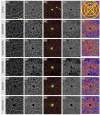Supervised Machine Learning Based Multi-Task Artificial Intelligence Classification of Retinopathies
- PMID: 31216768
- PMCID: PMC6617139
- DOI: 10.3390/jcm8060872
Supervised Machine Learning Based Multi-Task Artificial Intelligence Classification of Retinopathies
Abstract
Artificial intelligence (AI) classification holds promise as a novel and affordable screening tool for clinical management of ocular diseases. Rural and underserved areas, which suffer from lack of access to experienced ophthalmologists may particularly benefit from this technology. Quantitative optical coherence tomography angiography (OCTA) imaging provides excellent capability to identify subtle vascular distortions, which are useful for classifying retinovascular diseases. However, application of AI for differentiation and classification of multiple eye diseases is not yet established. In this study, we demonstrate supervised machine learning based multi-task OCTA classification. We sought 1) to differentiate normal from diseased ocular conditions, 2) to differentiate different ocular disease conditions from each other, and 3) to stage the severity of each ocular condition. Quantitative OCTA features, including blood vessel tortuosity (BVT), blood vascular caliber (BVC), vessel perimeter index (VPI), blood vessel density (BVD), foveal avascular zone (FAZ) area (FAZ-A), and FAZ contour irregularity (FAZ-CI) were fully automatically extracted from the OCTA images. A stepwise backward elimination approach was employed to identify sensitive OCTA features and optimal-feature-combinations for the multi-task classification. For proof-of-concept demonstration, diabetic retinopathy (DR) and sickle cell retinopathy (SCR) were used to validate the supervised machine leaning classifier. The presented AI classification methodology is applicable and can be readily extended to other ocular diseases, holding promise to enable a mass-screening platform for clinical deployment and telemedicine.
Keywords: artificial intelligence; computer aided diagnosis; diabetic retinopathy; ophthalmology; optical coherence tomography angiography; quantitative analysis; sickle cell retinopathy; support vector machine.
Conflict of interest statement
Pending patent application: X. Yao, M. Alam, and J. I. Lim. No other competing interest for any other authors.
Figures





References
-
- Ting D.S.W., Cheung C.Y.-L., Lim G., Tan G.S.W., Quang N.D., Gan A., Hamzah H., Garcia-Franco R., San Yeo I.Y., Lee S.Y., et al. Development and validation of a deep learning system for diabetic retinopathy and related eye diseases using retinal images from multiethnic populations with diabetes. JAMA. 2017;318:2211–2223. doi: 10.1001/jama.2017.18152. - DOI - PMC - PubMed
Grants and funding
LinkOut - more resources
Full Text Sources
Molecular Biology Databases

